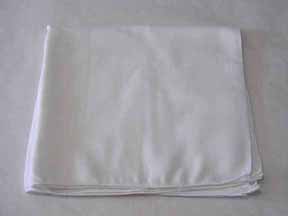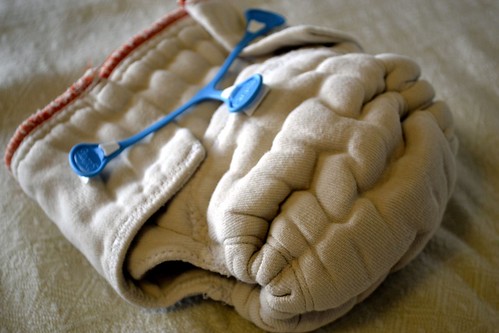Flat: A single layered fabric (typically cotton) that can be folded where absorbency is needed most, or simply folded into a square and used like a prefold. Cotton weaves include birdseye, muslin. Economical and one sized (can be doubled when baby is older). Receiving blankets can be used (but need to be pinned). You need a cover to make this type of diaper waterproof.
Prefold: A flat, layered, rectangular diaper with extra layers for absorbency in the center. Commonly used with a fastener and waterproof cover. Economical to buy and can be re-purposed as burp/cleaning cloths or inserts/doublers. Great for the newborn stage. You need a cover to make this type of diaper waterproof.

Pre-Fitted: A fitted diaper made from a prefold. Goes on like a disposable. May have snaps or aplix (a.k.a. velcro, hook and loop, touchtape) closure, or require pins or a Snappi. You need a cover to make this type of diaper waterproof. Easy DIY prefitted tutorial

Fitted: A shaped diaper that includes elasticized legs. Most commonly has an aplix or snap closure. You need a cover to make this type of diaper waterproof. Why choose fitteds?

Contour: Shaped, like a fitted diaper, but without elastic and usually without attached closures. Commonly used with pins or a Snappi. You need a cover to make this type of diaper waterproof.

Pocket: A 2 layered diaper that requires the addition of an absorbent insert. The outer layer is most commonly made of PUL, with the inner (the part that sits against baby's skin) usually being a "stay-dry" fabric (microfleece, suedecloth, etc.) that allows moisture to seep through to the insert, keeping baby's skin dry. Use a fresh, clean insert and pocket at each change. You do NOT need a cover to make this type of diaper waterproof.

All In One (AIO): The closest option to disposable diapers. Outside is made of a waterproof layer, and the absorbency is sewn in. You do NOT need a cover to make this type of diaper waterproof.

All In Two (AI2): Similar to an AIO, but with a removable absorbent layer for easier washing and faster drying. Absorbent layer is usually snapped in place inside the diaper, sitting directly against baby's skin. You do NOT need a cover to make this type of diaper waterproof.
Hybrid Diapers: These diapers feature a waterproof shell and different types of lay-in inserts that allow you to just replace the insert and continue using the shell. The different inserts may include disposable inserts, microfiber inserts, and some people even reuse trifolded prefolds as inserts.
Covers
Polyurethane Laminate (PUL): The waterproof fabric commonly used for making diapers and diaper covers. PUL covers can be air dried and reused in a day's rotation unless soiled with poo. 3-6 covers are usually adequate for a full diapering stash.
Nylon: Not as commonly used as PUL, but a popular economical alternative. Usually found in a pull-on style cover
Wool (Soakers, Shorties, Longies, Skirties): Wool yarn can be used to knit or crochet diaper covers that, once treated with lanolin, are quite waterproof. Wool covers also offer breathability that PUL covers do not, as well as certain antimicrobial properties. How to wash wool
Interlock (Soakers, Shorties, Longies, Skirties): Wool or acrylic yarn that has been tightly woven into more of a fabric than knitting or crocheting produces.
Acrylic (Soakers, Shorties, Longies, Skirties): Like wool, but made with acrylic yarn. Can be washed more often and washed/dried with your normal laundry.
Fleece (Soakers, Shorties, Longies, Skirties): A synthetic alternative to wool, fleece can be used as a diaper cover.
Soaker: A term for a diaper cover made of wool, acrylic, or fleece, most commonly in the form of a pull-on (rather than wrap w/ aplix or snap closure).
Accessories
Pins: Special safety pins used to fasten certain types of diapers.
Snappi: An alternative to pins. 2-3 is usually adequate for a full diapering stash.
Aplix, Touchtape: Velcro
Liners: Piece of fabric or paper that is laid into a diaper to protect the diaper from creams, make removal of poo easier, or provide a "stay-dry" feeling on baby's skin. Most of the paper liners on the market are flushable. Fleece liners are easily and cheaply made by cutting synthetic fabric store microfleece into rectangles.
Inserts: Separate absorbent layers for use inside pocket diapers.
Doublers: Extra (usually smaller) inserts for use in combination with primary inserts.
Soaker: Another term for the absorbent layer of any diaper.
Pails and Storage
Wet Pail: A dirty diaper storage pail that employs water and/or additives in which dirty diapers soak until wash day. Wet pails are not recommended as they pose a drowning hazard.
Dry Pail: A dirty diaper storage pail that does not use liquids to soak diapers. Dirty diapers are sprayed, scraped, or wiped of solids, and then simply tossed in the dry pail until wash day.
Combating Pail Stink: Though some moms use commercially marketed diaper pails with success, the most common solutions seem to be simple lidded plastic trash cans, buckets, or tall laundry hampers. Most seem to agree that the more air that can circulate around the diapers, the less stink they have (and their home still smells normal as well!) Cleaning the inside of the pail on wash day goes a long way toward getting rid of any smell, as does a few drops of essential oil (like Tea Tree Oil) on a small piece of cloth tossed into the pail (some pail liners even come with a piece sewn in for this purpose).
Washing and Drying
Detergent: You cannot use just any detergent on your cloth diapers. Those with whiteners and softeners may cause your diapers to repel (instead of absorb) moisture. Common advice is to use a small amount of detergent to wash diapers, in order to help prevent buildup and skin irritation. A good link on different detergents here
Pre-Rinsing: Most cloth diaper users do a cold pre-rinse with no detergent in their washing machine before doing the actual wash cycle to rinse away urine and any leftover solids.
Washing: Wash routines may vary according to your detergent, washing machine, type of water, etc.
Extra Rinses: Some cloth diaper users do extra rinse cycles at the end of their wash in order to ensure that all of the detergent has been washed away.
Drying Methods: Some diapers and covers require line drying, and some can be machine dried. Line drying diapers with aplix closures and/or PUL may help extend the life of those components.
Laundry Additives: Depending on the type of water you have (soft or hard), softening additives may be necessary to get diapers clean in the wash. Essential oils may also be added to the wash water to add scent. Though fabric softener is never recommended for cloth diapers, white vinegar is commonly used in it's place, as well as in a pre-wash rinse cycle to help combat ammonia buildup.
Stripping: The act of removing detergent buildup or other contaminants (ammonia, yeast, etc.) from diapers, usually involving multiple hot wash cycles, multiple extra rinses, boiling, blue Dawn dish detergent, and less commonly a dishwasher. How to strip
Sunning: The act of removing stains from diapers by drying in bright sunlight. Lemon juice may also be used when sunning stains for extra whitening.
No comments:
Post a Comment